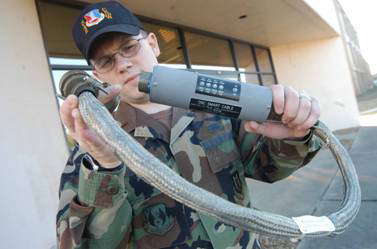 The Air Force tapped Warner Robins Air Logistics Center, Robins AFB, Ga., to lead a tiger team to discover why missile warning systems failed to function on several aircraft under fire near Baghdad in 2003 and 2004. Working with the Aeronautical Systems Center at Wright-Patterson AFB, Ohio, the team came up with the Smart Cable, a device that officials say has already saved airlift aircraft from missile attack. The team began designing, testing, and producing the cable in March 2004, installing the first one that summer. A process that normally would require up to five years or more was done in five months. Among the 400 coalition aircraft that have the cable, the cable performed well until a year ago when some of the aircraft developed power supply problems. Another team has developed and tested a power supply fix.
The Air Force tapped Warner Robins Air Logistics Center, Robins AFB, Ga., to lead a tiger team to discover why missile warning systems failed to function on several aircraft under fire near Baghdad in 2003 and 2004. Working with the Aeronautical Systems Center at Wright-Patterson AFB, Ohio, the team came up with the Smart Cable, a device that officials say has already saved airlift aircraft from missile attack. The team began designing, testing, and producing the cable in March 2004, installing the first one that summer. A process that normally would require up to five years or more was done in five months. Among the 400 coalition aircraft that have the cable, the cable performed well until a year ago when some of the aircraft developed power supply problems. Another team has developed and tested a power supply fix.
The U.S. military is maintaining a beefed-up presence in the Middle East, including fighters and air defense assets, following the U.S. strikes on Iranian nuclear facilities June 22 and subsequent retaliation by the Iranians against Al Udeid Air Base in Qatar.
